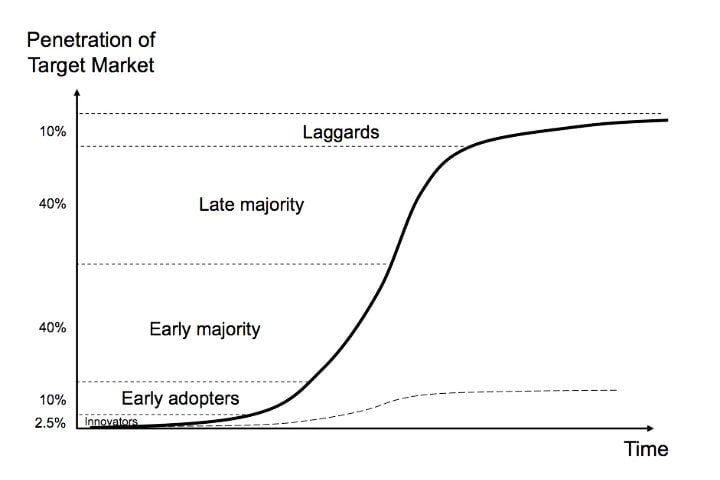Diffusion of Innovations Theory
Everett Rogers created the Diffusion of Innovations theory in 1962, which serves as a crucial framework in communication studies for explaining how, why, and how quickly new ideas and technologies spread across cultures. For UGC-NET aspirants in the field of mass communication and journalism, understanding this theory is crucial, as it provides insights into the adoption of new media technologies, the spread of information, and the role of communication in social change.
This theory is particularly relevant in the Indian context, given the country’s diverse cultural landscape and the rapid adoption of new technologies in recent years. In this comprehensive exploration, we’ll delve deep into the Diffusion of Innovations theory, examining its components, applications, strengths, limitations, and relevance in the Indian media and communication context.
Components of the Diffusion of Innovations Theory
1. Innovation
2. Communication Channels
3. Time
4. Social System
5. Adopter Categories
6. Innovation-Decision Process
Let’s examine each of these components in detail:
Innovation
An innovation is an idea, practice, or object perceived as new by an individual or other unit of adoption.
For instance, the introduction of mobile payment systems like Paytm or Google Pay in India.
Communication Channels
These are the means by which messages get from one individual to another.
For instance, in Indian society, word of mouth is in rural communities, and social media platforms like WhatsApp are in urban areas.
Time
The theory considers time in three ways: the innovation-decision process, the innovativeness of an individual or unit, and an innovation’s rate of adoption.
In the Indian context, consider the time taken for the adoption of digital streaming platforms like Hotstar across different segments of Indian society.
Social System
This is a set of interrelated units engaged in joint problem-solving to accomplish a common goal.
For example, the Bollywood film industry is adopting digital distribution methods of films to discourage the piracy of films.
Adopter Categories
Rogers categorized adopters into five groups:
- Innovators
- Early Adopters
- Early Majorities
- Late Majorities
- Laggards
In the adoption of smartphones in India, tech-savvy urban youth might be innovators, while elderly rural populations might be in the late majority or laggards category.
Innovation-Decision Process
This process consists of five stages:
- Knowledge
- Persuasion
- Decision
- Implementation
- Confirmation
For instance, a farmer who is interested in evaluating, making a decision to adopt, putting into practice, and verifying the advantages of a new agricultural technique recommended by agricultural extension services.
Applications of the Diffusion of Innovations Theory
Let’s explore how this theory can be applied to various scenarios:
Digital India Initiative
- Innovation: E-governance services
- Communication Channels: Government advertisements, local officials, digital literacy programs
- Time: Ongoing process since 2015
- Social System: Indian citizens, government departments
- Adopter Categories: Urban populations as early adopters, rural areas as late majority
- Innovation-Decision Process: From awareness campaigns to actual usage of digital services
Adoption of OTT Platforms
- Innovation: Streaming services like Netflix, Amazon Prime
- Communication Channels: Social media, word of mouth, traditional advertising
- Time: Rapid adoption in urban areas, slower in rural regions
- Social System: Indian entertainment consumers
- Adopter Categories: Young urban professionals as early adopters, older generations as late majority
- Innovation-Decision Process: From free trials to paid subscriptions
Spread of COVID-19 Information
- Innovation: New health guidelines and practices
- Communication Channels: Mass media, social media, government announcements
- Time: Rapid dissemination due to urgency
- Social System: Indian society at large
- Adopter Categories: Health-conscious individuals as early adopters, skeptics as laggards
- Innovation-Decision Process: From awareness to implementation of safety measures
Strengths of the Diffusion of Innovations Theory
1. Comprehensive Framework: Provides a holistic view of how innovations spread through society.
2. Versatility: Can be applied to various types of innovations across different cultures and contexts.
3. Predictive Power: Helps in predicting the likelihood of adoption of new ideas or technologies.
4. Focus on Communication: Emphasizes the role of communication channels in the spread of innovations.
Limitations of the Diffusion of Innovations Theory
1. Pro-Innovation Bias: Tends to assume that all innovations are positive and should be adopted.
2. Individual-Blame Bias: May place too much responsibility on individuals for non-adoption rather than considering systemic factors.
3. Recall Problem: Relies on individuals’ recall of adoption, which may not always be accurate.
4. Inequality Issues: Doesn’t adequately address how existing inequalities affect the diffusion process.
The Diffusion of Innovations Theory in the Digital Age
While Rogers’ theory predates the internet era, it remains highly relevant in the digital age:

1. Rapid Diffusion: Digital technologies often spread faster than traditional innovations, challenging the typical S-curve of adoption.
2. Multiple Innovations: The theory can help understand the adoption of various digital platforms and services simultaneously.
3. Global Reach: Digital communication channels allow for faster and wider diffusion of innovations across geographical boundaries.
4. Influencer Impact: Social media influencers can be seen as modern opinion leaders in the diffusion process.
Case Study: Diffusion of Innovations and the Adoption of UPI in India
Let’s apply the theory to the adoption of Unified Payments Interface (UPI) in India:
- Innovation: UPI-based payment systems
- Communication Channels: Bank promotions, word of mouth, social media
- Time: Rapid adoption since 2016, accelerated during the COVID-19 pandemic
- Social System: Indian financial ecosystem
- Adopter Categories: Tech-savvy urban population as early adopters, small merchants and rural areas as late majority
- Innovation-Decision Process: From awareness through government campaigns to widespread usage
This case demonstrates how the Diffusion of Innovations theory can be applied to understand the adoption of financial technology in India.
Criticism and Evolution
While the Diffusion of Innovations theory has been widely influential, it has faced criticism for its potential oversimplification of complex social processes and its pro-innovation bias. Critics argue that it doesn’t adequately account for cultural and social factors that might influence adoption rates.
In response to these criticisms, Rogers and other scholars have refined the theory over time, incorporating more nuanced understandings of social systems and the role of cultural factors in innovation adoption.
Diffusion of Innovations and Media Literacy
The theory offers valuable insights for media literacy education:
1. Critical Evaluation: Encourages critical thinking about new media technologies and their potential impacts.
2. Adoption Patterns: Helps in understanding personal and societal patterns of technology adoption.
3. Digital Divide Awareness: Highlights issues of access and adoption that contribute to digital divides.
In India, where technology adoption rates vary widely across different segments of society, understanding the Diffusion of Innovations theory can enhance media literacy efforts and inform digital inclusion policies.
Conclusion
The Diffusion of Innovations theory, with its comprehensive framework for understanding how new ideas and technologies spread through societies, remains a crucial concept in communication studies. For UGC-NET aspirants, mastering this theory is essential not only for exam success but also for developing a nuanced understanding of media adoption and social change processes in the diverse Indian context.
As we’ve seen, the theory can be applied to various scenarios in India’s media and communication landscape, from the adoption of digital payment systems to the spread of public health information. While it has limitations, particularly in fully capturing the complexities of cultural and social factors influencing adoption, it continues to provide a valuable foundation for analyzing innovation diffusion processes.
In an era of rapid technological change and digital transformation, Rogers’ insights into the factors influencing innovation adoption remain highly relevant. The theory reminds us that the spread of new ideas and technologies is not just a matter of their inherent qualities but also of social processes, communication channels, and individual decision-making.
UGC NET Exam Tips
1. Understand the five adopter categories and their characteristics.
2. Be familiar with the stages of the Innovation-Decision Process.
3. Practice applying the theory to various communication and technology adoption scenarios in India.
4. Understand both the strengths and limitations of the theory.
5. Consider how the theory might be adapted or challenged in the context of rapid digital innovation and diverse cultural contexts in India.




